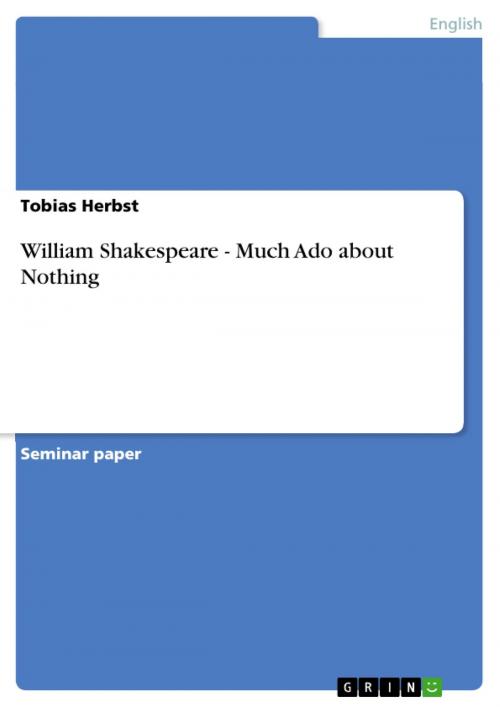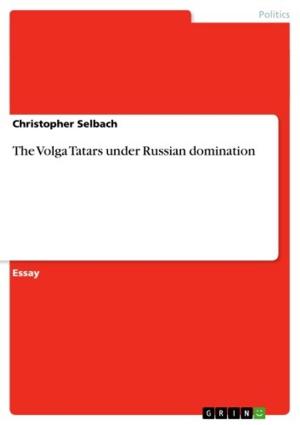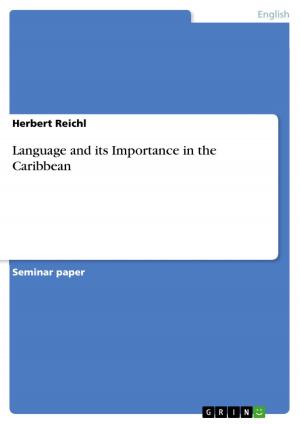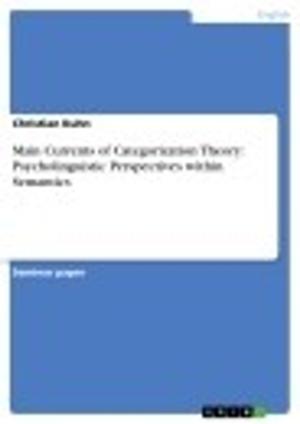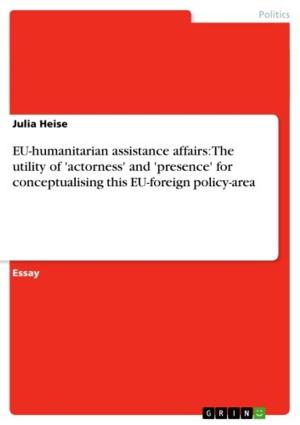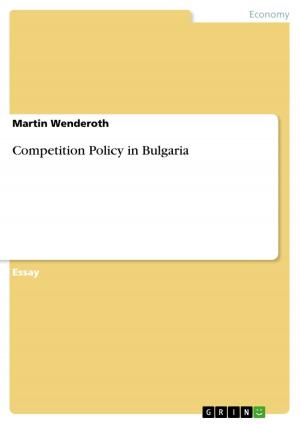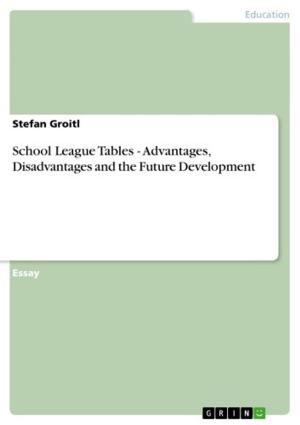William Shakespeare - Much Ado about Nothing
Much Ado about Nothing
Fiction & Literature, Literary Theory & Criticism, British| Author: | Tobias Herbst | ISBN: | 9783638572378 |
| Publisher: | GRIN Publishing | Publication: | November 22, 2006 |
| Imprint: | GRIN Publishing | Language: | English |
| Author: | Tobias Herbst |
| ISBN: | 9783638572378 |
| Publisher: | GRIN Publishing |
| Publication: | November 22, 2006 |
| Imprint: | GRIN Publishing |
| Language: | English |
Seminar paper from the year 2005 in the subject English Language and Literature Studies - Literature, grade: 2,0, University of Kassel, 9 entries in the bibliography, language: English, abstract: William Shakespeare's comedy Much Ado about Nothing was written sometime between 1598 and 1599 because it was first performed in the year of the comic actor Will Kemp, who played the role of Dogberry. This makes the play one of Shakespeare's later comedies. Although it is nowadays not regarded as one of Shakespeare's most brilliant works it was said to be very popular during his days and the following century. The play itself is often described as an atypical Shakespearean comedy. Even though it is comic, it has some disturbing elements because the plot is too serious for a comedy and occasionally the play seems only steps away from becoming a tragedy. Although, like in other Shakespearean comedies, no character dies during the play, Hero's pretended death makes the topic of 'death' more vividly present in this play. The comedy consists of four plots altogether: the main plot of Hero's and Claudio's love, the contrast plot including Benedick's and Beatrice's battle of wits, the subplot with Don Pedro, Father Francis and the subject of grace and, finally, Don John's intrigue against Claudio and Hero. The aim of this term paper is to analyse the plot of Don John's intrigue against the aristocrat couple Claudio and Hero. Therefore, Don John's character has to be pointed out in detail in a first step. The focus is put especially on the question how he is presented in the play and how and when the reader realizes that he has dedicated himself to evil. Afterwards, the Bastard's intrigue will be described and examined in depth. Actually, Don John carries out two dark schemes during the play: A first one which fails soon and a second one which is mainly known as 'the intrigue' today. Both attempts to foil the intended marriage of Claudio and Hero will be illustrated, before the focus is put on Don John's function in the play. Here the purpose of his existence and his actions will be questioned and analyzed. Finally, the subject whether the whole intrigue could have been prevented by anyone will be discussed briefly and especially Don Pedro's and Claudio's behaviour and its consequences for the whole plot will be in the centre of attention.
Seminar paper from the year 2005 in the subject English Language and Literature Studies - Literature, grade: 2,0, University of Kassel, 9 entries in the bibliography, language: English, abstract: William Shakespeare's comedy Much Ado about Nothing was written sometime between 1598 and 1599 because it was first performed in the year of the comic actor Will Kemp, who played the role of Dogberry. This makes the play one of Shakespeare's later comedies. Although it is nowadays not regarded as one of Shakespeare's most brilliant works it was said to be very popular during his days and the following century. The play itself is often described as an atypical Shakespearean comedy. Even though it is comic, it has some disturbing elements because the plot is too serious for a comedy and occasionally the play seems only steps away from becoming a tragedy. Although, like in other Shakespearean comedies, no character dies during the play, Hero's pretended death makes the topic of 'death' more vividly present in this play. The comedy consists of four plots altogether: the main plot of Hero's and Claudio's love, the contrast plot including Benedick's and Beatrice's battle of wits, the subplot with Don Pedro, Father Francis and the subject of grace and, finally, Don John's intrigue against Claudio and Hero. The aim of this term paper is to analyse the plot of Don John's intrigue against the aristocrat couple Claudio and Hero. Therefore, Don John's character has to be pointed out in detail in a first step. The focus is put especially on the question how he is presented in the play and how and when the reader realizes that he has dedicated himself to evil. Afterwards, the Bastard's intrigue will be described and examined in depth. Actually, Don John carries out two dark schemes during the play: A first one which fails soon and a second one which is mainly known as 'the intrigue' today. Both attempts to foil the intended marriage of Claudio and Hero will be illustrated, before the focus is put on Don John's function in the play. Here the purpose of his existence and his actions will be questioned and analyzed. Finally, the subject whether the whole intrigue could have been prevented by anyone will be discussed briefly and especially Don Pedro's and Claudio's behaviour and its consequences for the whole plot will be in the centre of attention.
